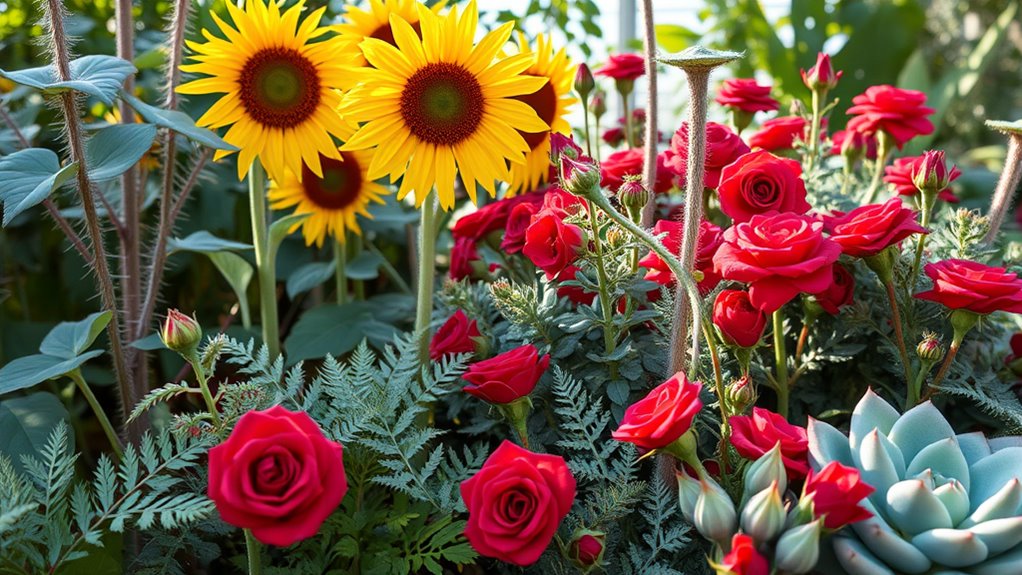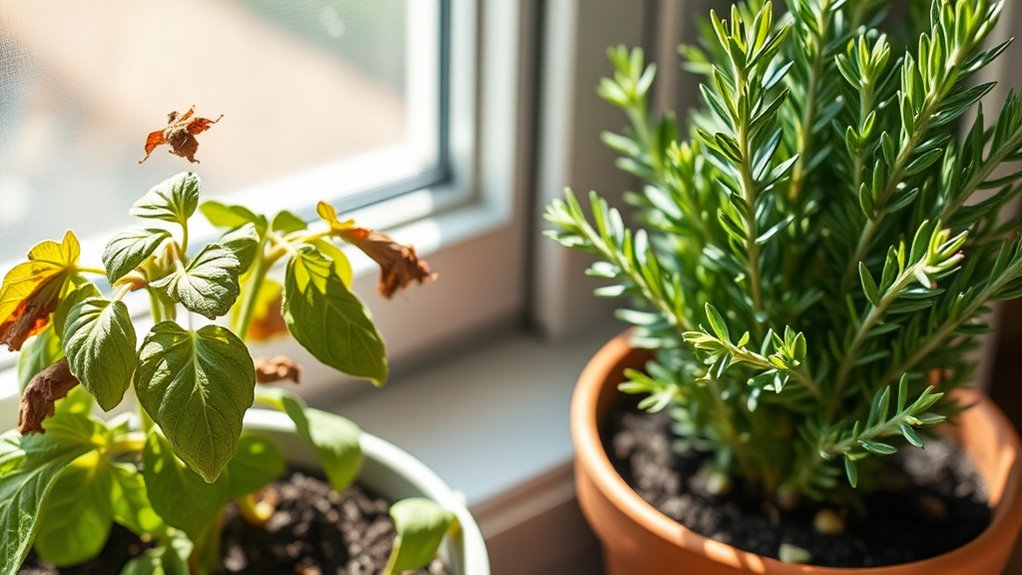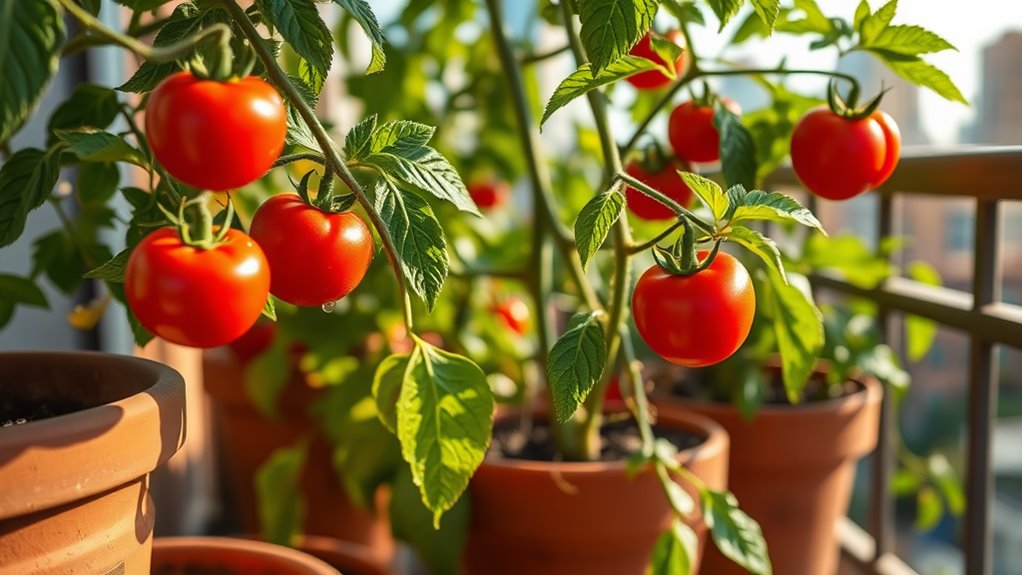These 9 Herbs Thrive on Neglect – Are They in Your Garden.
You’ve got mint, thyme, oregano, rosemary, sage, lavender, chives, lemon balm, and marjoram thriving in your garden, as they excel in neglectful conditions with minimal water and poor soil. Mint spreads via underground runners, oregano through rhizomes, and thyme uses deep roots for drought tolerance, while all resist pests and propagate easily from cuttings or seeds. They’re perfect for low-maintenance harvests. See how these hardy traits boost your garden’s resilience.
Key Takeaways
- Nine herbs like mint and oregano thrive with minimal water and care, ideal for low-maintenance gardens.
- Thyme and rosemary excel in poor, dry soils, requiring little attention beyond occasional pruning.
- Sage and lavender are drought-tolerant and pest-resistant, flourishing in sunny, well-drained spots.
- Chives and lemon balm spread easily and repel insects naturally, needing only basic division.
- Marjoram grows bushy with scant watering, offering aromatic benefits for effortless cultivation.
Mint
One of the hardiest herbs, mint thrives on neglect, spreading vigorously through underground runners even in poor soil.
In your herb gardening tips, you’ll find mint requires minimal intervention; plant it in pots to control its invasive roots, as it quickly dominates beds.
You propagate easily by dividing clumps in spring, ensuring vigorous growth with little water or fertilizer.
Prune regularly to promote bushy foliage, and it repels insects like aphids naturally.
For optimal flavor, harvest before flowering, integrating mint into low-maintenance gardens for teas and cooking.
With its easy growth, mint helps achieve fresh flavors in your everyday meals.
As one of the nine resilient herbs, mint exemplifies the ease of incorporating such plants into any garden setup.
Thyme
You notice thyme’s exceptional drought tolerance, enabling it to thrive with minimal watering.
Its hardy roots adapt easily to poor soil, resisting common issues like compaction.
This resilience lets you cultivate thyme in neglected spots without constant attention.
To further support its health, always monitor for signs of overwatering that could harm even drought-tolerant plants.
By applying expert watering techniques, you can prevent common mistakes that might undermine its natural hardiness.
Thyme’s Drought Tolerance
Thyme demonstrates exceptional drought tolerance, thriving in dry soils where many plants falter.
You notice its deep root system draws moisture from far below, conserving water efficiently during hot spells. Its small, waxy leaves minimize evaporation, allowing it to withstand prolonged dry periods without wilting.
In your garden, you’ll find thyme bounces back quickly after droughts, as its adaptive physiology reduces water loss. This makes it ideal for low-maintenance spots; you won’t need to water it often, saving you time and effort while it flourishes reliably.
Test its resilience in your own dry areas today.
Hardy in Poor Soil
Beyond its drought tolerance, Thyme excels in poor soil by leveraging a deep, fibrous root system that efficiently scavenges scarce nutrients, ensuring robust growth even in rocky or depleted grounds where other plants struggle.
This adaptation lets you cultivate Thyme in nutrient-poor conditions, as its roots form mycorrhizal partnerships that boost mineral uptake, like phosphorus and potassium, without amendments.
You’ll appreciate how Thyme’s technical resilience minimizes your efforts; it tolerates pH extremes and compaction, yielding aromatic foliage reliably.
Oregano
Oregano, a hardy perennial herb, thrives in poor soil and dry conditions, requiring little more than occasional watering to flourish.
You’ll appreciate its resilience; it spreads via rhizomes, making it ideal for ground cover in sunny spots.
Propagate from cuttings or seeds, as it self-sows readily.
Prune regularly to promote bushier growth and prevent legginess, enhancing its aromatic oils.
In your kitchen, you harvest fresh leaves for robust flavor in Italian dishes, while its compounds offer antibacterial benefits.
Drought-tolerant and pest-resistant, oregano demands minimal intervention to yield abundant harvests year after year. This resilience supports organic gardening tips by enhancing plant health naturally.
As an excellent choice for beginner gardeners, it fits seamlessly into low-effort planting strategies.
Rosemary
You grow rosemary easily in poor soil, where its robust roots adapt without extra amendments.
It demands minimal water, thriving on the occasional drink to prevent root rot.
This resilience lets you maintain a flavorful herb with effortless care. Incorporating sustainable fertilizing can enhance its vitality while supporting eco-friendly practices.
Pairing this with organic gardening hacks allows for even more sustainable cultivation.
[LIST OF 3 SUBHEADING DISCUSSION POINTS IN ENGLISH
Rosemary, a hardy herb that flourishes with minimal care, offers three key discussion points: its drought-resistant growth habits, which allow it to thrive in poor soil; the low-maintenance pruning and watering needs that suit neglectful gardeners; and its versatile applications in cooking and natural remedies. You’ll find pruning rosemary simple—you snip it actively to promote bushiness, watering it sparingly keeps it vibrant, and its leaves enhance your meals or remedies effectively.
| Discussion Point | Key Feature | Practical Tip |
|---|---|---|
| Drought Resistance | Withstands dry spells | Plant in sunny spots |
| Low-Maintenance Care | Minimal pruning needed | Trim only when leggy |
| Versatile Uses | Flavorful and medicinal | Infuse in oils or teas |
Thrives in Poor Soil
One key advantage of rosemary is its ability to flourish in nutrient-poor soils, where many plants struggle.
You’ll find it thrives in sandy, rocky, or alkaline conditions because its deep root system efficiently scavenges limited minerals and water from subsoil layers.
This hardy herb adapts through specialized enzymes that optimize nutrient uptake, reducing reliance on fertilizers.
As you cultivate rosemary, note its preference for well-drained soils with pH 6-7, minimizing risks of root rot.
Needs Minimal Water
While rosemary’s deep root system efficiently accesses subsoil moisture, it thrives with minimal watering, demanding only occasional irrigation to prevent drought stress.
You’ll water it sparingly, ideally every two weeks, allowing soil to dry completely between sessions to promote deeper roots and enhance drought tolerance. This approach minimizes fungal risks and sustains growth in arid conditions.
Test soil moisture before irrigating; if the top layer feels dry, that’s your signal.
Rosemary’s adaptations make it ideal for low-effort gardens, letting you focus on harvesting its robust, aromatic leaves for culinary use.
Sage
Sage, a resilient perennial herb (Salvia officinalis), thrives in neglectful conditions where others fail, demanding little water or attention once established.
You’ll appreciate its drought tolerance, flourishing in sandy or rocky soils with excellent drainage, where it reaches 2-3 feet in height.
Its woody stems and fuzzy leaves contain volatile oils, including thujone, which deter pests naturally.
Propagate sage from cuttings in spring; it self-seeds readily, returning annually.
In your garden, it enhances flavor in dishes while boosting soil health through deep roots, requiring only occasional pruning to maintain shape. Similar to the journey of embracing organic gardening, incorporating sage can lead to a bountiful harvest by naturally supporting sustainable practices.
With its adaptability, sage is also ideal for indoor herb growing, enabling fresh availability year-round for your cooking endeavors.
Lavender
Lavender, a hardy perennial herb (Lavandula angustifolia), thrives in neglectful environments, requiring scant water or care once rooted.
You’ll find it flourishes in well-drained, alkaline soils under full sun, where it resists pests and diseases with minimal intervention.
Its drought tolerance stems from deep roots that access moisture efficiently, so you won’t need to fertilize or prune often—deadheading spent flowers maintains shape.
Technically, lavender’s essential oils deter insects, enhancing garden ecology.
Plant cuttings in spring for propagation; it’s straightforward and low-effort, ensuring long-term vigor in your neglected spots. For instance, lavender supports a healthy garden ecosystem by naturally repelling pests through its aromatic properties.
Additionally, lavender serves as an effective component in natural pest control strategies due to its insect-repelling properties.
Chives
Chives (Allium schoenpratum), a resilient perennial, handle neglect well, forming dense clumps in sunny to partly shaded spots with minimal watering once established.
You’ll find they repel pests naturally, thanks to their sulfur compounds, which deter insects from your garden.
Divide clumps every few years to maintain vigor; they propagate easily from bulbs or seeds.
In your kitchen, you harvest fresh leaves for flavoring dishes, as they contain allicin for health benefits.
They’re drought-tolerant, thriving in poor soil, so you won’t need fertilizers—focus on well-drained spots to prevent root rot.
Lemon Balm
Lemon balm (Melissa officinalis) is a resilient perennial that flourishes with minimal attention, forming lush clumps in sunny to partially shaded areas with well-drained soil.
You’ll appreciate its vigorous spread via rhizomes, which enables quick establishment as ground cover. It tolerates poor soil and drought once rooted, reducing your watering needs.
The leaves contain essential oils like citronellal and geraniol, prized for their calming, aromatic qualities in teas or extracts.
Harvest frequently using sharp shears; it regenerates rapidly without fertilizer. It’s also pest-resistant, thriving unattended while attracting beneficial pollinators like bees.
Marjoram
Marjoram (Origanum majorana) flourishes with scant attention, much like lemon balm, as a perennial that forms bushy mounds in full sun and well-drained soil.
You’ll find it tolerates drought once established, requiring minimal watering or fertilization to thrive. Its compact growth deters pests, and you can propagate it easily from cuttings or seeds.
Technically, marjoram’s essential oils offer antimicrobial properties, making it ideal for teas or seasoning.
Harvest leaves regularly to encourage bushier plants, but don’t over-prune; this herb rewards your neglect with aromatic, flavorful yields year after year.





